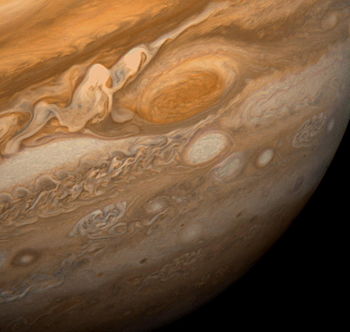Jupiter (planet)
Jupiter is the fifth planet from the Sun and the largest in the Solar system. It is a gas giant (also known as the Jovian planet).
Parameters for classification as a planet
Jupiter is classified as a planet by the International Astronomical Union for meeting the following criteria:[1]
- Orbits the Sun;
- Has mass sufficient for its gravity to form a nearly round shape;
- Has mass sufficient for gravity to clear a path in its orbit.
Physical characteristics
Jupiter is a little more than five times further away from the Sun than Earth (5.2 AU) and is the most massive of the planets with a total mass of about 318 times that of Earth (318 Earth masses). Its total mass is about 2.5 times all the other planets combined. See Benchmark quantities for more perspective about Jupiter's mass.
- Equatorial Radius: 71,492 km
- Volume: 1.4255 X10e15 km^3
- Mass: 1.8987 X10e27 kg[2]
It is composed largely of hydrogen and helium. Jupiter's strong internal heat creates a number of semi-permanent features in its atmosphere, such as cloud bands and the Great Red Spot.
Great Red Spot
Jupiter's Great Red Spot is believed to be a giant hurricane rotating within the planet clouds. The first recorded observation was made by Italian-French astronomer Jean-Dominique Cassini in 1655. Three hundred years later it is still active. The spot is a cold, high-pressure area, 2 to 3 times the diameter of Earth. Its outer edges make a complete rotation in a counter clockwise motion about once every six days.[3]
The red spot rises about 8 km above the surrounding clouds. Its red colour is a mystery but current theories posit that it may be caused by material dredged up from below the cloud tops.[4]
Oval BA
Jupiter shows a number of other storms that are much smaller than the Great Red Spot. However, in June of 2000, a number of these smaller storms were seen to coalesce and form a larger storm center. The storm, labelled Oval BA (aka Red Spot Jr.) has since developed a reddish colour and looks very much like the Great Red Spot though much smaller.[4]
Rotational characteristics
Jupiter has a rotational period (a complete rotation on its axis) of 9.842 hours and a polar tilt of 3°.[5]
Orbital characteristics
Jupiter has an orbital period (sidereal year) of 11.68 earth years. It has an average distance from the Sun of 778,412,020 km.[6] At its closest approach to the Sun (perihelion) it is nearly 5 times the distance of the Earth from the Sun (4.95 AU). At its furthest distance from the Sun (aphelion) it is 5.45 AU from the Sun.[5]
Natural satellites
Jupiter has 63 satellites, of which 50 have been given official names. Most of the recently discovered moons orbit Jupiter in a retrograde direction, which suggests that they are captured objects, not native to the Jovian satellite system.[7] The four largest are Ganymede, Callisto, Io and Europa. They show similarities to the terrestrial planets, such as volcanism and internal heating.[8] Ganymede is the largest satellite in the Solar System, and is larger than Mercury.
Ganymede, Callisto, Io, and Europa have an important place in the history of science. At the time they were discovered in 1610 by Galileo Galilei (using a telescope of his own design), Ptolemy’s geocentric (Earth-centered) view of the universe prevailed. Then, Johannes Kepler confirmed the observations a short time later.
Since these were the first objects observed in orbit around another celestial body and not in orbit around the Earth, the observations were the first direct evidence for the Copernican model of the cosmos and a direct contradiction of the Ptolemeic model which had prevailed from the second century A.D.
Named by Galileo the Medician Stars after his benefactor Cosimo Medici II, they are collectively referred to as the Galiean satellites (after their discoverer Galileo).[9]
References
- ↑ Honey, I Shrunk the Solar System NASA. “The International Astronomical Union has decided that, to be called a planet, an object must have three traits. It must orbit the sun, be massive enough that its own gravity pulls it into a nearly round shape, and be dominant enough to clear away objects in its neighborhood.”
- ↑ Jupiter NASA
- ↑ Galileo, Cassini, and the Great Red Spot NASA
- ↑ 4.0 4.1 Jupiter's new red spot NASA
- ↑ 5.0 5.1 The orbits of the planets National Maritime Museum
- ↑ Jupiter NASA
- ↑ http://burro.astr.cwru.edu/stu/jupiter_moons.html
- ↑ Pappalardo, R T (1999). Geology of the Icy Galilean Satellites: A Framework for Compositional Studies. Brown University. Retrieved on 2006-01-16.
- ↑ John Gribbin (2002). Science: A History. London: Allen Lane The Penguin Press.
External Links
- Jupiter's Great Red Spot Hubble Heritage Project

